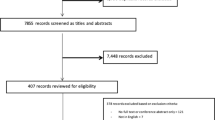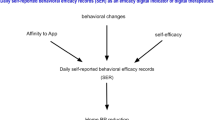Abstract
Home blood pressure monitoring (HBPM) can improve hypertension management. Digital tools to facilitate routinized HBPM and patient self-care are underutilized and lack evidence of effectiveness. MyBP provides video-based education and automated text messaging to support continuous BP self-monitoring with recurring feedback. In this pragmatic trial, we sought to generate preliminary evidence of feasibility and efficacy in community-dwelling adults ≥55 y/o with hypertension recruited from primary care offices. Enrollees were provided a standard automatic BP cuff and randomized 2:1 to MyBP vs treatment-as-usual (control). Engagement with MyBP was defined as the proportion of BP reading prompts for which a reading was submitted, tracked over successive 2-week monitoring periods. Preliminary measures of efficacy included BP readings from phone-supervised home measurements and a self-efficacy questionnaire. Sixty-two participants (40 women, 33 Blacks, mean age 66, mean office BP 164/91) were randomized to MyBP (n = 41) or a control group (n = 21). Median follow-up was 22.9 (SD = 6.7) weeks. In the MyBP group, median engagement with HBPM was 82.7% (Q1 = 52.5, Q3 = 89.6) and sustained over time. The decline in systolic [12 mm Hg (SD = 17)] and diastolic BP [5 mm Hg (SD = 7)] did not differ between the two treatment groups. However, participants with higher baseline systolic BP assigned to MyBP had a greater decline compared to controls [interaction effect estimate −0.56 (−0.96, −0.17)]. Overall hypertension self-efficacy improved in the MyBP group. In conclusion, trial results show that older hypertensive adults with substantial minority representation had sustained engagement with this digital self-monitoring program and may benefit clinically.
This is a preview of subscription content, access via your institution
Access options
Subscribe to this journal
Receive 12 digital issues and online access to articles
$119.00 per year
only $9.92 per issue
Buy this article
- Purchase on Springer Link
- Instant access to full article PDF
Prices may be subject to local taxes which are calculated during checkout



Similar content being viewed by others
References
Collaborators GBDRF. Global, regional, and national comparative risk assessment of 79 behavioural, environmental and occupational, and metabolic risks or clusters of risks, 1990-2015: a systematic analysis for the global burden of disease study 2015. Lancet. 2016;388:1659–724.
Muntner P, Hardy ST, Fine LJ, Jaeger BC, Wozniak G, Levitan EB, et al. Trends in blood pressure control among us adults with hypertension, 1999–2000 to 2017-8. JAMA. 2020
Collaboration NCDRF. Long-term and recent trends in hypertension awareness, treatment, and control in 12 high-income countries: an analysis of 123 nationally representative surveys. Lancet. 2019;394:639–51.
Heisler M, Hogan MM, Hofer TP, Schmittdiel JA, Pladevall M, Kerr EA. When more is not better: treatment intensification among hypertensive patients with poor medication adherence. Circulation. 2008;117:2884–92.
Muldoon MF, Kronish IM, Shimbo D. Of signal and noise: overcoming challenges in blood pressure measurement to optimize hypertension care. Circ Cardiovasc Qual Outcomes. 2018;11:e004543.
Siu AL, USPST Force. Screening for high blood pressure in adults: U.S. Preventive services task force recommendation statement. Ann Intern Med. 2015;163:778–86.
Shimbo D, Artinian NT, Basile JN, Krakoff LR, Margolis KL, Rakotz MK, et al. Self-measured blood pressure monitoring at home: A joint policy statement from the American heart association and American medical association. Circulation. 2020:CIR0000000000000803
NICE. Hypertension in adults: diagnosis and management. National Institute for Health and Care Excellence. 2019;136
Centre NG. Hypertension in adults: diagnosis and management. National Institute for Health and Care Excellence. 2019;136
(UK) NGC. Hypertension in adults: diagnosis and management. National Insitute for Health and Care Excellence. 2019;136
National Guideline Centre (UK). Hypertension in adults: diagnosis and management. National Institute for Health and Care Excellence. 2019;136
National, Guideline, Centre, (UK). Hypertension in adults: diagnosis and management. National Institute for Health and Care Excellence. 2019;136
Unger T, Borghi C, Charchar F, Khan NA, Poulter NR, Prabhakaran D, et al. 2020 international society of hypertension global hypertension practice guidelines. J Hypertens. 2020;38:982–1004.
Tucker KL, Sheppard JP, Stevens R, Bosworth HB, Bove A, Bray EP, et al. Self-monitoring of blood pressure in hypertension: a systematic review and individual patient data meta-analysis. PLoS Med. 2017;14:e1002389.
Fletcher BR, Hartmann-Boyce J, Hinton L, McManus RJ. The effect of self-monitoring of blood pressure on medication adherence and lifestyle factors: a systematic review and meta-analysis. Am J Hypertens. 2015;28:1209–21.
Bosworth HB, Powers BJ, Olsen MK, McCant F, Grubber J, Smith V, et al. Home blood pressure management and improved blood pressure control: results from a randomized controlled trial. Arch Intern Med. 2011;171:1173–80.
Green BB, Cook AJ, Ralston JD, Fishman PA, Catz SL, Carlson J, et al. Effectiveness of home blood pressure monitoring, web communication, and pharmacist care on hypertension control: a randomized controlled trial. JAMA. 2008;299:2857–67.
Margolis KL, Asche SE, Bergdall AR, Dehmer SP, Groen SE, Kadrmas HM, et al. Effect of home blood pressure telemonitoring and pharmacist management on blood pressure control: a cluster randomized clinical trial. JAMA. 2013;310:46–56.
Omboni S. Connected health in hypertension management. Front Cardiovasc Med. 2019;6:76.
Murphy AR, Suffoletto BP, Muldoon MF. Matchmaking and the Future of Hypertension Management. Circulation: Cardiovascular Quality and Outcomes. https://doi.org/10.1161/circoutcomes.120.007062.
Ogedegbe G, Tobin JN, Fernandez S, Cassells A, Diaz-Gloster M, Khalida C, et al. Counseling African Americans to control hypertension: cluster-randomized clinical trial main effects. Circulation. 2014;129:2044–51.
Cottrell E, Cox T, O’Connell P, Chambers R. Implementation of simple telehealth to manage hypertension in general practice: a service evaluation. BMC Fam Pract. 2015;16:83.
Persell SD, Peprah YA, Lipiszko D, Lee JY, Li JJ, Ciolino JD, et al. Effect of home blood pressure monitoring via a smartphone hypertension coaching application or tracking application on adults with uncontrolled hypertension: a randomized clinical trial. JAMA Netw Open. 2020;3:e200255.
Irizarry T, Allen M, Suffoletto BP, Einhorn J, Burke LE, Kamarck TW, et al. Development and preliminary feasibility of an automated hypertension self-management system. Am J Med. 2018;131:1125 e1121–1125 e1128.
Allen ME, Irizarry T, Einhorn J, Kamarck TW, Suffoletto BP, Burke LE, et al. SMS-facilitated home blood pressure monitoring: a qualitative analysis of resultant health behavior change. Patient Educ Couns. 2019;102:2246–53.
Kario K, Shimbo D, Hoshide S, Wang JG, Asayama K, Ohkubo T, et al. Emergence of home blood pressure-guided management of hypertension based on global evidence. Hypertension. 2019:HYPERTENSIONAHA11912630.
Rogoza AN, Pavlova TS, Sergeeva MV. Validation of a&d ua-767 device for the self-measurement of blood pressure. Blood Press Monit. 2000;5:227–31.
Powers BJ, Olsen MK, Smith VA, Woolson RF, Bosworth HB, Oddone EZ. Measuring blood pressure for decision making and quality reporting: where and how many measures? Ann Intern Med. 2011;154:781–8. W-289-790
Bello NA, Schwartz JE, Kronish IM, Oparil S, Anstey DE, Wei Y, et al. Number of measurements needed to obtain a reliable estimate of home blood pressure: results from the improving the detection of hypertension study. J Am Heart Assoc. 2018;7:e008658.
Karpman C, Lebrasseur NK, Depew ZS, Novotny PJ, Benzo RP. Measuring gait speed in the out-patient clinic: methodology and feasibility. Respir Care. 2014;59:531–7.
Roque NA, Boot WR. A new tool for assessing mobile device proficiency in older adults: the mobile device proficiency questionnaire. J Appl Gerontol. 2018;37:131–56.
Wan SH, Hart M, Hajjar I. A novel measurement index for antihypertensive medication burden and its use. Hypertension. 2009;54:e135–136.
Baer JS, Holt CS, Lichtenstein E. Self-efficacy and smoking reexamined: construct validity and clinical utility. J Consult Clin Psychol. 1986;54:846–52. https://doi.org/10.1037//0022-006x.54.6.846.
van Buuren S. Multiple imputation of discrete and continuous data by fully conditional specification. Stat Methods Med Res. 2007;16:219–42.
Graham JW, Olchowski AE, Gilreath TD. How many imputations are really needed? Some practical clarifications of multiple imputation theory. Prev Sci. 2007;8:206–13.
van Buuren S, Groothuis-Oudshoorn K. Mice: multivariate imputation by chained equations in R. J Stat Softw. 2011;45.
Alessa T, Abdi S, Hawley MS, de Witte L. Mobile apps to support the self-management of hypertension: Systematic review of effectiveness, usability, and user satisfaction. JMIR Mhealth Uhealth. 2018;6:e10723.
Bengtsson U, Kjellgren K, Hallberg I, Lindwall M, Taft C. Improved blood pressure control using an interactive mobile phone support system. J Clin Hypertens. 2016;18:101–8.
Piette JD, Datwani H, Gaudioso S, Foster SM, Westphal J, Perry W, et al. Hypertension management using mobile technology and home blood pressure monitoring: results of a randomized trial in two low/middle-income countries. Telemed J E Health. 2012;18:613–20.
McKinstry B, Hanley J, Wild S, Pagliari C, Paterson M, Lewis S. et al. Telemonitoring based service redesign for the management of uncontrolled hypertension: multicentre randomised controlled trial. BMJ. 2013;346:f3030
Kim SGK, Muller M, Grosz BJ. Acceptance of mobile technology by older adults: a preliminary study. in: Proceedings of the 18th international conference on human-computer interactions with mobile devices and services (MobileHCI ‘16). 2016:147–57
McManus RJ, Mant J, Bray EP, Holder R, Jones MI, Greenfield S, et al. Telemonitoring and self-management in the control of hypertension (tasminh2): a randomised controlled trial. Lancet. 2010;376:163–72.
Acknowledgements
We gratefully acknowledge the following organizations and individuals whose contributions were integral to the successful completion of this investigation: The Aging Institute of UPMC Senior Services for funding; Patients, providers, and staff from area regional primary care offices who participated or assisted in the study; Mr. Jack Doman who programmed MyBP; Emmi Solutions, Inc. whose hypertension education videos were used through a lease agreement with UPMC Health System.
Author information
Authors and Affiliations
Corresponding author
Ethics declarations
Competing interests
The authors declare no competing interests.
Additional information
Publisher’s note Springer Nature remains neutral with regard to jurisdictional claims in published maps and institutional affiliations.
Supplementary information
Rights and permissions
About this article
Cite this article
Muldoon, M.F., Einhorn, J., Yabes, J.G. et al. Randomized feasibility trial of a digital intervention for hypertension self-management. J Hum Hypertens 36, 718–725 (2022). https://doi.org/10.1038/s41371-021-00574-9
Received:
Revised:
Accepted:
Published:
Issue Date:
DOI: https://doi.org/10.1038/s41371-021-00574-9



